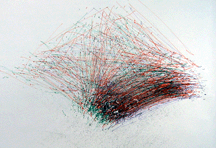

Hilary Spurling's two-volume biography of Henri Matisse leaves no doubt as to the reaction
of families, friends and compatriots in the face of his magnificent obsession with painting.
First his parents and neighbors, when he was young and expected to take over the family feed
store, cast scorn upon his choice of art. Tragically, in his later years as well, his children and many in the art world tried to control his output, determine his subject-matter
and dictate the workings of his studio. Creative people of every sort will recognize the
rejection and disparagement of those around them. There is something about the spirit of
independence and the need to follow an inner voice that strikes fear into others.
This month we point you to several recent studies of the brains of creative people, in the
hope that you will pursue the subject in depth on your own. Oh, and have you hugged an artist lately?
In 2002, Britain's Science Museum produced an extensive exhibit on the anatomy of the brain, the connection between its insides and its outsides, and the model of
a mind that is so essential to artificial intelligence. Titled "Head On: Art with the Brain in Mind", the exhibit utilized the works of artists in the
Wellcome Trust, and attempted to integrate studies in science and creativity, art
and bioscience, philosophy and neuroscience. The curator's
statement begins: "It weighs 1.5kg and contains 28 billion cells, with a mind-boggling 10,000 billion connections between them. We each have one, and yet they are all different. While we are alive, they are constantly switched 'on';
turning them 'off' kills us." The Museum reminds us that Albert Einstein's brain has been
exhaustively analyzed, while the brain of Charles Babbage (inventor of the computer) was
retained in two halves by the Royal College of Surgeons. More information can be found at
http://www.wellcome.ac.uk/node77109.html
Several new studies claim to have observed differences in the functioning of brains of gifted individuals versus those with normal intelligence. The differences were especially remarkable in the area of the brain called the posterior parietal cortex, long thought to contain memory. Scientists noted that this area was enlarged in Albert Einstein's brain.
An alternative theory, however, states that highly intelligent people have less, not more, activity in the cerebral cortex because their brains are simply more efficient. Details can
be found at
http://www.world-science.net/exclusives/050902_intelfrm.htm
Psychologists have discovered that Rembrandt used modern theories of brain activity in his paintings. He also seems to have treated males and females differently. In male portraits, for example, 74% of the models present their left cheek to the viewer, while the same percentage of female models shows the right cheek. Researchers studying the
artist's work showed his paintings to 73 college students. The students found the women
models to be more "approachable", while the men were felt to be more threatening. Details
can be found at
http://www.world-science.net/exclusives/051013_rembrandtfrm.htm
c.Corinne Whitaker 2005


 United States and Australian researchers at laboratories across the world from each other claim to have developed a new kind of creature, the "semi-living artist", whose output is controlled by the brain signals of several thousand rat neurons in a petri dish. The commands of the neurons are communicated to a robotic arm by means of a Multi-Electrode Array (MEA). The mechanical arm is situated at the University of Western Australia in Perth, while the rat neurons are located at the Georgia Institute of Technology. The scientists hope to create an entity that can evolve, learn, and create art to express itself. The
semi-living artist follows another project called "Fish and Chips", which used music to
stumulate fish neurons into moving a robotic arm. You will find more at
http://www.gatech.edu/news-room/release.php?id=160
United States and Australian researchers at laboratories across the world from each other claim to have developed a new kind of creature, the "semi-living artist", whose output is controlled by the brain signals of several thousand rat neurons in a petri dish. The commands of the neurons are communicated to a robotic arm by means of a Multi-Electrode Array (MEA). The mechanical arm is situated at the University of Western Australia in Perth, while the rat neurons are located at the Georgia Institute of Technology. The scientists hope to create an entity that can evolve, learn, and create art to express itself. The
semi-living artist follows another project called "Fish and Chips", which used music to
stumulate fish neurons into moving a robotic arm. You will find more at
http://www.gatech.edu/news-room/release.php?id=160

